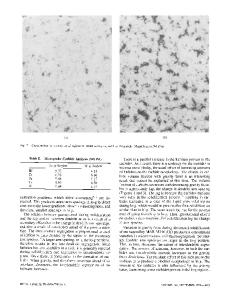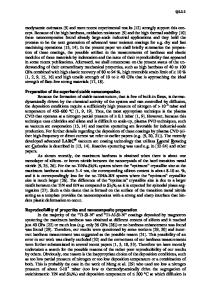Thermal stability of the nickel-base superalloy B-1900 + Hf with tantalum variations
- PDF / 2,253,327 Bytes
- 11 Pages / 594 x 774 pts Page_size
- 90 Downloads / 303 Views
INTRODUCTION T H E microstructure and mechanical properties of nickelbase superalloys are typically evaluated when the material is in the solutionized and aged heat-treat condition. However, exposure to high temperatures for extended periods of time has been shown to affect the microstructure of nickel-base superalloys in a variety of ways. The volume fraction of the primary strengthening phase, y ' , may decrease (partial solutionization), in addition to changes in the 3/' morphology, distribution, and particle size. ~-~ The MC carbides may break down to form M6C and/or M23C6 carbides, possibly with an undesirable morphology or location in the microstructure. 7'8 Topologically-close-packed (TCP) phases, such as /x, o', or Laves, may also form in compositionally unstable alloys. ~'z'7'8 These microstructural changes, particularly 3" agglomeration, have been shown to be generally detrimental to 760 ~ and 982 ~ tensile and creep properties? In the present study, the effects of aging on the microstructure of B-1900 + Hf-type alloys with Ta variations at 982 ~ were investigated. Previous studies of long-term agingl 3.9 have qualitatively evaluated the relative stabilities of carbide, boride, and intermetatlic phases between 760 ~ and 1205 ~ in a variety of superalloys, including the B-1900 (without Hf). The aim of the present work was to examine quantitatively the changes in the y and y ' phase compositions, the y ' volume fraction, and the stability (including composition) of the carbides and minor phases after aging at 982 ~ for 72, 250, and 1000 hours. It has also been demonstrated that the addition of Ta to solutionized and aged B-1900 + Hf results in an increase in the y ' fraction and the Ta level of the y and 3" phases. 10In addition, Hf was partially displaced from the MC carbides by Ta and partitioned to the y ' phase. These microstructural changes have been shown to improve the high temperature mechanical properties of directionally solidified and single
G.M. JANOWSK1, Graduate Student, and B.J. PLETKA, Professor, are with the Department of Metallurgical Engineering, Michigan Technological University, Houghton, MI 49931. B.S. HARMON, formerly an Undergraduate Student, Department of Metallurgical Engineering, Michigan Technological University, is with Howmet Turbine Components Corporation, Whitehall, MI 49461. Manuscript submitted July 15, 1986. METALLURGICALTRANSACTIONS A
crystal MAR-M247 "'12. and would be expected to have a *MAR-M is a trademark of Martin Marietta Company.
similar effect on the mechanical properties of B-1900 + Hf. It is necessary, however, to ascertain if these effects of Ta on the microstructure are present after additional aging since phenomena such as partial solutionization of the y ' phase can occur. Therefore, the goals of this study are two-fold: (1) to determine what effects long-term aging has on the microstructure and phase compositions of B-1900 + Hf-type alloys and (2) to determine if the beneficial effects of Ta on the microstructure are maintained during long-term aging.
Data Loading...











